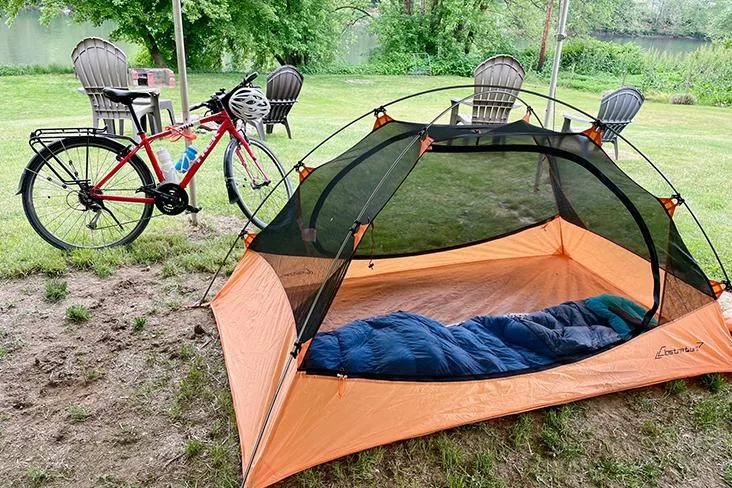Why I Started Combining Biking with Camping
It all began one summer when I was planning a solo camping trip to the Pacific Northwest. I’ve always loved being in nature, but I was craving a new kind of adventure. A friend casually mentioned bikepacking, and something just clicked. The idea of pedaling through forest trails, reaching remote campgrounds, and living out of my panniers felt like the perfect blend of challenge and escape.
That first trip was eye-opening—not just because of the breathtaking views but because I learned so much about combining cycling with camping. Now, it’s become my favorite way to travel, and I want to share what I’ve learned so you can enjoy the ride too.
1. Choosing the Right Bike for Camping Adventures
Not every bike is built for the demands of a camping trip. I made the mistake once of using a regular road bike, and trust me, it wasn’t fun. For bike camping, I recommend a touring bike or a gravel bike. They’re sturdy, can carry more weight, and are designed for longer rides over varied terrain.
Look for bikes with mounting points for racks and fenders. I personally use a steel-frame touring bike—it’s a bit heavier, but it handles weight well and is incredibly reliable on rugged trails.
2. Essential Gear to Pack
2.1 Bike Bags and Storage Solutions
I use a mix of panniers and a frame bag to distribute weight evenly. My handlebar bag holds snacks and a map (yes, I still like having a paper one), while rear panniers carry most of my gear. Packing light is key—only bring what you absolutely need.
2.2 Camping Equipment
I opt for ultralight camping gear. A compact tent, sleeping pad, and a lightweight sleeping bag are musts. Don’t forget a camp stove and cookware, especially if you’ll be far from stores. I usually bring instant oats, trail mix, and freeze-dried meals.
3. Planning Your Route: Trails and Campgrounds
Planning is where the fun starts. I use a combination of apps like Komoot and Ride with GPS to map out bike-friendly routes that pass by campgrounds or allow for wild camping. In the U.S., many state parks and national forests are perfect for this. I once did a trip along the Oregon Coast and camped at hiker-biker sites every night—it was magical.
Make sure to consider elevation changes, road surfaces, and water sources. I learned the hard way during a trip in Utah when I underestimated how remote some areas were—always carry more water than you think you'll need!
4. Staying Safe and Comfortable on the Trail
4.1 Bike Maintenance and Repair
Bring a multi-tool, patch kit, spare tubes, and a mini pump. You don’t want to be stuck in the middle of nowhere with a flat. I always do a full bike check the night before every trip.
4.2 Wildlife and Weather Awareness
Being in the wild means being prepared. I’ve had close encounters with raccoons and one unforgettable (and safe) bear sighting. Use bear-proof containers where required and always hang your food if needed. As for the weather, always pack layers—even summer nights can get chilly in the mountains.
5. Making It Fun: Stories from the Trail
On one trip through Shenandoah National Park, I met a couple who were biking across the country. We ended up sharing stories around a campfire under a sky so full of stars it felt unreal. That’s one of the beautiful things about bike camping—you become part of a community, even if just for a night.
Another time, in the Adirondacks, I stumbled upon a hidden lake I would have never found by car. I swam alone in the cool, clear water and watched a heron glide by. Moments like that make every uphill climb worth it.
6. Family and Group Biking Adventures
Bike camping isn’t just for solo adventurers. I’ve gone on trips with friends and even taken my nephew along. With a bit of extra planning—like shorter routes and more snack breaks—it becomes a wonderful bonding experience. Many U.S. parks have dedicated family-friendly trails and campsites with amenities for kids.
7. Resources to Help You Get Started
If you’re feeling inspired but unsure where to begin, start small. Try a weekend overnight trip to a nearby state park. Local bike shops often have group rides or might know local bike camping routes. You can also find guided tours if you prefer a structured experience at first.
For those planning a more extended trip, websites like Bikepacking.com and Adventure Cycling Association offer incredible route guides and gear advice. And if you're looking for a peaceful, bike-friendly resort to start your journey from, check out our offerings at Pine Cliff Resort. We're happy to help you plan the perfect getaway on two wheels.







